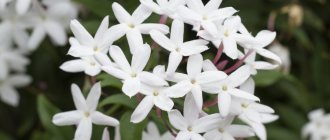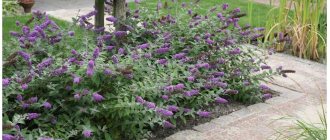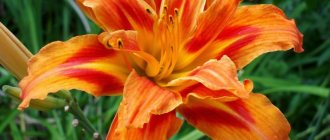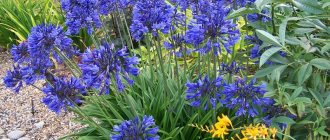Decorative hosta foliage will decorate any flower garden. Hostas go well with perennials, annuals and conifers. I developed an interest in these plants a long time ago, but never had the opportunity to use them on my site. And now, when I am faced with the task of creating a flowerbed from scratch from perennials, this plant seems irreplaceable to me. Why will I use hosts:
- Decorative foliage will dilute fresh perennials that have not yet gained strength.
- The plant will add volume to the new flower garden.
- It is possible to receive planting material for free (relatives:).
I understand perfectly well that hosta seedlings also need time to begin to please the eye. But this flower garden is more like a long-term plan. I am thinking through the scheme so that in the future I will get an attractive and well-groomed flower bed.
Something like this
And this requires more than one season. Still, perennials take a long time to reveal their power and beauty.
I want to implement the following flower bed scheme with hostas and other perennials.
And now more about the plant, so as not to make a mistake with the place of sale, soil preparation, and choice of varieties.
Landing place
Hostas should not be planted in full sun; there should be partial shade. Where the area is illuminated from 12 noon to 5 pm, it is better not to place these plants. I’m planning a place for a flower garden on the north side of the house, and it provides good shade. The sun is there only a couple of hours after sunrise in the morning and only a little bit in the evening. In open areas of the hosta, the foliage fades, the contrasting border fades, and burns appear.
Trees or shrubs growing nearby can also provide partial shade. Constant dense shade will also not benefit the plants. In spring, the ground in such areas takes longer to warm up, as a result of which the development of new shoots is inhibited. And flower stalks may not form at all.
Hosta Orange Marmalade - variegated plant
Hosta Orange Marmalade is a bright, showy variety that has been known since 2002. It is a sport from the Pauls Glory function (originator - R. Solberg). The name of this variety is translated as “Orange (or orange) marmalade.” The plant is very popular due to its decorative foliage, shade tolerance and unpretentiousness.
Hosta orange marmalade description
Soil preparation
Small deviations in soil composition from the ideal are unlikely to noticeably affect the appearance. Hostas are fairly unpretentious plants. But there are some recommendations from experienced gardeners:
- The composition of the soil is light loam, neutral, slightly alkaline or slightly acidic. Nutritious and well-drained soil. It is important to maintain moist soil, but at the same time avoid stagnation of water; it is better not to plant a swamp.
- It is advisable to add moisture retainers to sandy soil - peat, humus, compost. It will not be superfluous to mulch the plantings.
- Clay soil is diluted with fine gravel, organic matter with coarse fiber, and good drainage is provided.
- Avoid alkalizing the soil. Apply acidic peat and neutralize the alkali using other means. Yellowing leaves and loss of brightness will indicate that the plant needs acidification.
- On the unflooded shore of a reservoir, most hosta varieties reveal all their beauty. Increased humidity promotes the development of decorative foliage and helps to gain strength faster.
Common diseases
Now it’s time to talk about hosta diseases and their treatment. Although this culture has a fairly good immune system, it is still sometimes subject to some misfortunes. The most well-known disease is powdery mildew, which appears after leaves are exposed to ice water. For treatment, you can use any proven fungicide, for example, the drug “Fitosporin” (dilute strictly according to the instructions).
Gray mold is another common ailment that can be easily confused with sunburn. In fact, the cause of the development of the disease is high air humidity. Although the plant loves to contain a large amount of water in the soil, if it does not properly evaporate from the upper layers, it will sooner or later provoke the development of an infection. Fungicides and complete cutting out of diseased areas will also help to cope with the scourge.
Planting in open ground
A seedling with 2-3 buds and a healthy rhizome with elastic roots 10-12 cm long is suitable for planting. Hostas tolerate replanting well, but it is better to do this in cloudy weather in the fall.
- For a medium-sized seedling, prepare a hole approximately 30*30cm, and lay drainage on the bottom.
- Compost, peat and complex fertilizers are added to the soil (no more than 50 grams for this volume of depression).
- The plant is placed in a prepared hole, the roots are straightened and covered with soil. Tamp down a little and water.
- The ground around the plant is mulched with bark or peat. The root collar is not deeply buried, maximum 1-2 cm.
- There should be at least 50 cm between seedlings.
Watering
Since drizzling rain and high soil moisture are “native” for hosta, the garden should be kept in the most approximate conditions possible. Young specimens are watered especially carefully, but even adult bushes cannot do without water if they are dry.
When determining how to care for hosta, a big mistake beginners make is shallow watering. With this procedure, the leaf blade gets wet, and the root does not receive enough moisture. Drops of water on the leaves are a high probability of sunburn. That is why it is recommended to water the plant abundantly at the root - up to 15 liters of water are poured under an adult bush. Proper watering is when the soil is completely saturated to a depth of 50 cm.
The ideal time for watering is early morning. It is especially important to follow this rule in hot weather. Do not water the hosta during the day, as this leads to burns. Evening watering can attract slugs and snails.
How to care
Caring for a hosta is no different from the standard: timely watering, regular loosening of the soil, applying fertilizer, pruning shoots after flowering and mulching.
Watering
After planting in open ground, it is necessary to water every 3-4 days if there is no rain. It is advisable to maintain this regime until a new leaf appears. Then water as needed, only in the morning; evening watering is excluded. If there is a prolonged drought, it is necessary to moisten the soil daily, at the root, avoiding water getting on the foliage. The optimal solution is drip irrigation; it is provided for at the site planning stage.
Loosening
If we do not mulch the soil, then loosening should be carried out regularly, while simultaneously removing weeds. It is advisable to do this after watering.
Top dressing
It is permissible to carry out several feedings per year. In the spring, before the leaves appear, nitrogen-containing fertilizers are applied; they contribute to the growth of green mass. The second feeding is carried out in mid-summer. during the flowering period with potassium-phosphorus preparations. The next feeding occurs at the end of August, using organic fertilizers, for example, mullein solution.
Trimming
It is mandatory to prune flower stalks immediately after flowering. If you do not plan to collect seeds. Damaged sheets - burnt or diseased - should be removed as soon as they appear. To stimulate the growth of dormant buds for the purpose of subsequent division of the bush, the foliage is mowed completely.
Mulching
For hostas, mulching the root zone is mandatory. This will help retain moisture and prevent the soil from crusting over. To do this, use pine needles, crushed bark, and peat. This creates almost ideal conditions for slugs under the hosta foliage. Therefore, we will prepare to fight them, periodically shake up the mulch and eliminate uninvited guests.
Hosta care
When growing and caring for hosts, a number of rules are followed.
Watering
Do it generously and frequently (twice a week). Water is added in the morning. The soil is kept moist, but moisture is not allowed to stagnate, otherwise the plant will be affected by fungus.
Fertilizing
During the growth period, fertilize three times. The first feeding is at the very beginning of growth. The second is after the formation of flowers. The third - after the buds fall off.
It is recommended to combine the application of complex products and compost. Immediately after fertilizing, the soil is mulched.
Reproduction
Hosta is grown from seeds or propagated by dividing the bush. Let's consider the features of these methods.
Growing Hosta from Seeds
This is a rather labor-intensive process. From the moment of sowing the seeds to the decorative appearance, at least three years will pass. Growing stages:
- Seeds are collected in September after ripening. We focus on the color of the seed pod - it should turn brown.
- Next, the collected material is cleared of debris and dried, placing it in a thin layer on a horizontal surface. In winter, the seeds are stored in a cool, dark, dry place.
- In the spring, before planting, they are soaked in a growth stimulator. Prepare nutritious soil, which is pre-disinfected by calcination or treatment with potassium permanganate. The soil is placed in pots or containers no more than 12 cm high that have drainage holes. Drainage is laid at the bottom, then a layer of nutrient soil. Next, moisten it and distribute the seeds. Cover the top with a small layer of soil - 0.5-1cm.
- Containers with future seedlings are placed in a warm place, but not in direct sunlight, away from radiators and drafts. Cover with film or glass until shoots appear. Next, monitor the soil moisture; it should not be overdried or waterlogged. It is better if watering is carried out through a tray.
- When the first leaves appear, you should pick. Once it becomes clear that the plant has tolerated the picking well, hardening can begin. To do this, the host is taken out for a short time to a balcony or street where there are no drafts. In July it is already possible to plant in open ground, avoiding strongly lit places. Otherwise, the plant will quickly burn in the sun. Let these be shaded areas or a place where the sun appears only in the morning.
Propagation of hostas by dividing the bush
Starting from the fourth year of the plant’s life, the adult hosta can be divided for propagation. The best time for this procedure is spring. Although the hosta can easily tolerate transplantation throughout the growing season.
- The hostas dig up the ground around them. The bush is lifted using a garden fork as a lever. Then the roots of the plant are placed in a solution of potassium permanganate and inspected for the presence of pests - slugs and snails. .
- Using a sharp instrument treated with an antiseptic, the hosta is divided into bushes according to their growth points. Rotten and dry roots should be removed.
- Next, a planting hole with drainage and fertilization is prepared for each plot. Cuttings are planted, compacted and watered, and mulched.
Pests, diseases
During the growth of the hosta, it is affected by various diseases, and gardeners constantly observe insect attacks:
| Pest/disease | Symptom (effect on foliage) | Elimination methods |
| Phyllostiosis | Red-brown spotting. | All diseased leaves are cut off and thrown away. Shrubs are sprayed with Vectra or Abiga-Peak, and colloidal sulfur is often used. |
| Botrytis | Rotting. | Treat with Bordeaux mixture or Topaz. The affected parts are destroyed. |
| Root collar rot | The rhizome is affected. | They dig it up, wash the root system, remove infected areas, and dip it in a light solution of potassium permanganate. Transported to a new location. |
| Slugs | Traces of dried mucus, holes. | A Thunderstorm bait is placed under the flower, covered with plywood in the evening, and pests are collected manually in the morning. |
| Foliar nematodes | Light brown spots. | The affected areas are destroyed. The soil is sprayed with a formaldehyde solution or the flower is moved to a new area, but the roots are first soaked in potassium permanganate. |
With timely detection of diseases and insects, the flower pleases with its flowering for a long time.
Varieties
Hosta has a wide variety of species, among which there are the most suitable options for growing in open ground.
White-edged
Hybrid with medium-sized broad-lanceolate leaves. It has rich shades of green mass with a white border. This gives the plant an elegant appearance. It blooms in mid-summer with small purple flowers.
Bloated
A dark green hosta with glossy leaves. The bract has a wide heart-shaped shape. It blooms with lilac or purple flowers on an erect peduncle. The color of the flowers will be lilac. The sheets are uneven, with small waves.
Ovoid
Notable for the round shape of the bushes, the green leaves are ovoid in shape. The peduncle can reach 50 cm. It blooms with lilac-blue flowers. The leaves of some varieties may have yellow stripes.
Wavy
A hybrid variety of hosta. The bract has an oblong, ovoid, wavy shape, with white inclusions in the center. The flowers resemble a bell and are purple in color. Blooms in mid-summer. Varieties of this species are represented by crops with green foliage with a white stripe or a light center.
Siebold
The bract has a combined heart-ovate shape. The leaves have a waxy coating on the surface. Blooms with pale lilac flowers. A popular species among gardeners, varieties and varieties also come in shades of grey, dove or blue. Siebold is very often used as a mother plant for breeding work; new varieties of perennial are bred.
Fortune
An artificially bred variety. Externally, the plant is similar to the previous species, but smaller in size. The heart-shaped bract has a waxy coating. When flowering, there are many funnel-shaped bells on the peduncle. Painted in purple shades. It blooms in late summer and includes several varieties of different leaf color and bract size.
Curly
The heart-shaped leaves of this hosta grow up to 16 cm in length. The peculiarity lies in the different colors of the outer and inner sides of the leaf: the bottom surface is glossy, the top is matte green, and the leaf has a white stripe along the edge. The flower stalks are long and clearly visible in the dense foliage. The inflorescence contains 30-40 flowers, 4-5 centimeters long. Petals are lilac with yellow anthers. It blooms in late summer and has a slow growth rate.
Lanceolate
The bract of this hosta is lanceolate-ovate, rich in color, with brown inclusions. The color of the flowers is purple with dark stripes. It blooms late and decorates the flower garden until late autumn.
Podorozhnovaya
The leaf also has an ovoid shape with a glossy surface. Dense flowering occurs in mid-summer. White bells with an unobtrusive aroma.
Erectifolia
This hosta can form a dense, dark green shrub with foliage growing vertically from the ground. It blooms with purple flowers throughout almost the entire summer.
Botanical portrait
The perennial has a compact rhizome, from which grows a dense rosette of basal leaves on long petioles.
The leaf blades are varied in size, structure, color - there are many variegated varieties and varieties, and also differ in shape - from narrow-lanceolate to broadly oval.
The height of the peduncles varies, in natural species it does not exceed 1 m, but varietal plants have flowering stems about 130 cm high, and recently giants 185 cm high have appeared along with the inflorescence.
The flowers are showy, bell-shaped or funnel-shaped, the corollas are 6-slit, usually of a delicate lilac or purple color, less often snow-white.
The raceme inflorescence consists of 6-8 flowers, located one-sided on the peduncle. The fruit is a leathery three-ribed capsule with flat black winged seeds.
Classification
There are several groups based on the external characteristics of both wild and hybrid species. The gradation of plants depends on size. According to the American classification, the following groups can be distinguished:
- dwarf - height does not exceed 10 centimeters;
- miniature – grow up to 15 centimeters;
- small - plants up to 25 centimeters;
- medium - grow up to half a meter;
- large – these hostas can reach 70 centimeters in height;
- gigantic - over 70 centimeters.
There are hosts that belong to intermediate groups of this classification.
In addition to size, the following features may be taken into account:
- leaf shape – round, oval, elongated, heart-shaped;
- type of leaf surface - corrugated, matte, glossy, wavy, bronze-metallic;
- green color – white, golden, gray and blue shades, deep green.
Popular varieties and types of hosta with photos
White feathers
One of the best varieties with white young leaves. As it grows, the veins turn green, and then the rest of the leaf. The size of the leaf plate is about 15x5 cm. It blooms in June-August with lilac leaves. Peduncles can reach 60 cm. The height of an adult plant is about 40 cm. It tolerates frosts down to -35°C, so it is suitable for most regions of Russia.
Gold standard
Large ovate leaves. The leaves are soft green with a dark green border and change their color to golden over time. They are about 25 cm long. It blooms in July-August with light lilac flowers. An adult hosta grows up to 70 cm in height and up to 120 cm in width. This should be taken into account before planting in a permanent location. Belongs to frost-resistant varieties.
Bright groom
The variety is distinguished by heart-shaped leaves, curved in an arc and a strongly wavy border. The bush is shaped like a fountain. It blooms at the end of summer on a peduncle about 45 cm high. A medium-sized plant up to 40 cm in height, up to 85 cm in diameter. Frost-resistant variety suitable for the climate of Moscow and the Moscow region.
Malachite Box
The leaves have a rounded shape and multi-colored lines - from malachite to milky green, measuring 20*30 cm. It blooms with white bells in July. Grows both in partial shade and in illuminated areas. The variety is frost-resistant, suitable for most regions of Russia.
Avocado
Large, fast-growing hosta with dense and convex leaves. Bright green in the center and darker at the edges. The similarity of shape and color with avocado gave the variety its name. Blooms with large bell-shaped flowers in August. Reaches 70 cm in height and 120 cm in width. It can be grown in the Urals, as it tolerates frosts down to -40 degrees.
Blue Angel
The fast-growing giant hosta has fluted leaves with a blue tint. Blooms in July-August with white flowers. It is resistant to diseases and pests. It can reach a height of 120 cm. Suitable for growing in regions with a temperate climate, tolerates frosts up to 35 degrees.
Atlantis
A hybrid variety growing up to 80 cm in height and up to 170 cm in width. It has a dense, bright green leaf plate with a wide border of yellow or cream color.
Antiochus
A medium-sized variety with powerful green leaves edged with a creamy white stripe along the edge. Blooms in June with lilac flowers.
August moon
It has large heart-shaped leaves from yellow-green to golden color. Grows up to 50cm in height and up to 1 meter in width. Blooms in July-August with pale lavender flowers. The variety is frost-resistant, tolerates temperatures down to -40 degrees.
Albomarginata
Hosta Albomarginata is suitable for growing by beginning gardeners. It has a dense bush up to 60 cm in height and up to 1 meter in width. The leaves are grooved, dark green with a white edge. Blooms with purple flowers. The ideal place for growing will be partial shade; it is not demanding on the soil. Overwinters at temperatures down to -35 degrees, resistant to pests and infections.
T. Rex
T Rex is a variety of giant hosta that reaches 120 cm in height. Suitable as an accent plant for a flower bed. The leaves are green, with pronounced veining. Blooms with white flowers in June-July.
Albopicta
It has large heart-shaped leaves, a dome-shaped bush, light green with a green border. Grows up to 70 cm in height and up to 1 meter in width. Blooms in mid-summer with lilac or blue flowers. Frost-resistant variety, reaches its greatest decorative value by 5 years of age.
Lipstick blonde
A very bright representative with rich yellow foliage on red stems. Medium height - up to 40 cm in height and up to 50 cm in width. Blooms in July with lavender flowers.
Blue ivory
The dense, heart-shaped leaves have a blue tint with a creamy edge. The bush grows low up to 50 cm, but can reach 1 meter in width. The brightest color appears in the shade and partial shade. It will look impressive as an accent in a flower bed or surrounded by a lawn.
Mouse ears
The leaves are dense, blue-green in color and have a slightly rounded shape. Refers to miniature species, no more than 20 cm in height. Hosta mouse ears has several varieties, slightly different in leaf shade and shape. It blooms with lilac or white flowers collected in racemes.
Brim Cap
Compact kut with small grooved cup-shaped leaves with a wide cream-colored border. Blooms in July-August with purple flowers. The height is small, up to 35 cm. It is a frost-resistant variety and tolerates frosts down to -35 degrees.
Is it worth covering the crop for the winter?
As mentioned earlier, this plant has good frost resistance. However, some varieties may not tolerate the climate of a particular region. So if your winters are particularly severe, then be sure to cover your crop for the winter with improvised materials or a special frame. Otherwise, you risk losing the ornamental crop that you have grown and cared for for so long.
As a rule, to protect the hosta from the cold, it will be enough to cut off all the leaves, and then mulch the soil with dry leaves or sawdust. However, if you are concerned about the health of the plant, you can build a special frame made of wood. The covering material is burlap or agrofibre. But the film should not be used under any circumstances, since the moisture from such a material simply does not evaporate.
How does hosta emerge after winter? At first you will see small green sprouts that look like sprouted onions. As soon as they appear, you can safely remove the cover and mulch so that the plant begins to receive a sufficient amount of sunny color. Over time, large and large leaves will appear from these sprouts, which will delight the owner of the hosta and his guests with their unsurpassed decorative qualities with some notes of exoticism.
What to plant next to hosta in the shade
Hosta companions are plants that do well in shade or partial shade. You can plant next to the hosta:
- Astilbe - will decorate the flowerbed with its blooming panicles;
- Heuchera is an unpretentious plant with bright leaves;
- Fern - will decorate a flowerbed with carved foliage;
- Primroses - add color to the flower garden in spring;
- Hydrangea - to form a bright multi-tiered flower bed.
Hosta with astilbe
Hostas with heucheras
Hosta with fern and ivy
Frequently asked questions from flower growers
Although there are practically no problems with growing hosta, sometimes questions still arise related to changing the appearance of the plant and arranging compositions in the garden.
What colors do hostas go with?
The ideal partner for hosta is filigree foliage and bright torches of astilbe inflorescences.
Its fluffy panicles will wonderfully decorate the mysterious foliage of the hosta.
A good neighbor and outdoor tradescantia Sweet Kate with low golden stems and bright blue flower eyes at the top.
Hostas go well with dicentras, ferns and peonies.
They are often planted against the background of coniferous plants, which emphasize the spreading nature and presentable beauty of the hosta.
Garden grasses - reed grass and miscanthus - add airiness to the mysterious composition of hostas, and daylilies, phlox and kupena create a vertical accent.
What to plant next to hostas in the flowerbed, along the fence and path
If you are designing a path along the edges of which you plan to plant hostas, then choose plants of the same variety. It is desirable that these be low-growing varieties. After planting, you need to be patient; the paths bordered by hostas will acquire a decorative appearance and completeness no sooner than after three seasons. You can complement the design with ground covers. Hostas - coleus in red shades will also perfectly complement the greenery. To make the hosta border look more picturesque in the spring, plant low primroses between them: crocuses, hyacinths, muscari.
Hosts along the tracks
When forming a composition along the fence, you can combine hosts with daylilies, irises, astilbe, and roses. In this case, it is necessary to observe tiers. Plan in advance the planting of plants in such a way that the decorative value of each of them is visible to your eye: low-growing plants in the foreground, behind them medium-height ones, and in the background - the tallest ones.
Hosta with hydrangeas
general characteristics
Just two decades ago, today’s popular hosta was known only to rare gardeners and breeders. Florists used it for their flower arrangements and that was the end of it. Now the situation has changed radically, and a beautiful decorative deciduous perennial can be found in many areas.
For a long time, the unusual plant was classified as daylilies and asparagus, and over time, botanists separated it into a separate family of the same name. The second name for hosta is funkia, but it is almost never used in everyday speech.
Photo: 2sotki.ru
In the garden, hosta goes well with lush ferns, conifers, geraniums, primrose, astilbe or anemone. In landscape design it is used as a beautiful ground cover plant with lush and bright foliage. There are even chameleon varieties whose foliage color changes throughout the season.
Hosta is suitable for framing vertical flower beds, decorating garden paths and lawns, and arranging gazebos. The smallest varieties barely grow to 10 cm, and the largest ones easily stretch over 70 cm.
The good thing about hosta for amateur gardeners is that its many varieties can easily be crossed with each other. So everyone can try to breed their own unique hybrids that easily take root and delight with longevity.
Photo: 2sotki.ru
Examples of using hosta in landscape design - photos
Hostas in front of the house
Flowerbed with hostas
Hostas by the pond
Contrasting combinations with hosta
Hosta in the recreation area











